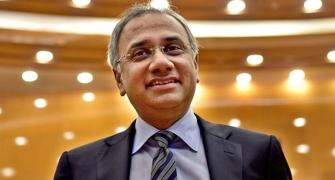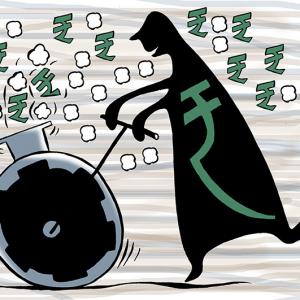The NCLAT's order is offensive because it goes against every tenet of bankruptcy reorganisation.
If Justice Sudhansu Mukhopadhyay’s tenets are accepted by the Supreme Court, we will not only regress in modern bankruptcy reorganisation but also slide back in the Doing Business rankings, says Omkar Goswami.

All hell broke loose in India’s legal and banking circles after the National Corporate Law Appellate Tribunal’s (NCLAT’s) decision in the Essar Steel case on July 4 this year.
The 116-page judgment, written by Justice Sudhansu Mukhopadhyay, chief of the NCLAT, has turned the fundamental tenets of bankruptcy restructuring upside down.
The commentariat’s views have been universally negative.
One headline screamed “NCLAT’s Essar Steel ruling negates the rights of secured creditors, makes mockery of the IBC (Insolvency and Bankruptcy Code)”.
Another wrote of “The Possible Perils of NCLAT’s Verdict”.
Yet another cried “NCLAT gets it totally wrong on Essar Steel”.
Rajnish Kumar, State Bank of India chairman, has said that lenders will be moving the Supreme Court against this order.
What is this offensive order?
Where does it stand vis-à-vis the IBC and globally accepted norms of desirable bankruptcy procedures?
These are some questions that I shall answer here.
Bankruptcy is about debt default.
Since debt is a contract between a borrower and a lender that must be adhered to irrespective of whether the former can service such debt, a universal principle of bankruptcy is that the lenders’ unpaid dues have to be settled in full before entertaining those of other claimants.
Within debt, there is a well-defined hierarchy of claimants.
First come the claims of secured creditors - typically banks and financial institutions - that have a charge on the debtor’s assets against their loans.
The IBC calls them “secured financial creditors”.
If there is any residual left after their claims, then come the unsecured creditors, who are trade creditors, government agencies with unpaid bills and dues of workmen - all having creditor rights, but no access to any security.
Under the IBC, they are called “operational creditors”.
There are two reasons why secured financial creditors have seniority in claims.
From a legal perspective, a lender having security of a borrower’s assets must be first taken care of, or else the security will remain with the lender.
More importantly, secured creditors are banks and financial institutions, which use public and depositors’ funds to make their advances.
Without seniority in claims, the entire edifice of banking faces huge systemic risks.
Banks price their secured loans at a lower rate precisely because of their lien on the borrowers’ assets.
Without that, they would charge much higher interest rates.
Now for bankruptcy resolution under the IBC.
Two sections are particularly important. The first is Section 30.
It states that the appointed professional who deals with a bankruptcy resolution must ensure that several conditions are met.
One is that the amount set aside in the plan for repaying the debts of unsecured operational creditors cannot be less than what would be paid to them in the event of liquidation.
It means that if the liquidation value can support Rs X crore towards paying operational creditors, then the resolution plan must incorporate at least that amount.
Other conditions under Section 30 are that: (i) the resolution professional shall present the plan to a Committee of Creditors (CoC) for approval; (ii) an approval occurs if it meets at least 75 per cent of the voting share of the financial creditors - essentially representing that share of outstanding secured debt; and (iii) on approval by the CoC, the plan shall be submitted to the adjudicating authority, which is the NCLT, or the NCLAT under appeal.
Section 31 states that if the adjudicating authority is satisfied that the resolution plan sanctioned by the CoC meets all the requirements under Section 30, it shall issue an order approving the plan, which shall be binding on all parties concerned.
Section 31 is where Justice Mukhopadhyay has played a Machiavellian game to show that the NCLAT is not just an authority that shall approve a CoC sanctioned plan but that it can substantially alter it as well.
This is what he has done. First, in para 148, he ingeniously interprets a Supreme Court decision to argue that operational creditors be given “roughly the same treatment” as financial creditors - something that goes against the grain of the IBC and bankruptcy.
Second, in para 149 and thereafter, he highlights “a huge discrimination” between the operational and financial creditors made by the CoC in distributing the Rs 42,000 crore offered by ArcelorMittal to take over Essar Steel.
Third, Justice Mukhopadhyay bizarrely interprets definitions of “financial creditor” and “financial debt” in Sections 5(7) and 5(8) of the IBC to proffer the mother of all arguments: That a financial creditor “cannot be sub-classified as ‘Secured’ or ‘Unsecured’… [in] the ‘Resolution Plan’” [para 164] - an interpretation that goes against all tenets of bankruptcy reorganisation or liquidation.
Justice Mukhopadhyay then says while operational creditors cannot be paid less in reorganisation than in liquidation (Section 53), it “does not mean that they should not be provided… more” (para 169).
Based on that, he nullifies the allocations made by the CoC, and comes up with an inexplicable “fairness” interpretation - where all creditors, financial or operational, should be treated on a par. (The Mukhopadhyay formula is given below.)
Compared to the CoC proposal, Justice Mukhopadhyay reduces the financial creditors’ debt dues by 39 per cent to Rs 30,030 crore, and ups those of the operational creditors by 136 per cent to Rs 11,970 crore.
This order is offensive because it goes against every tenet of bankruptcy reorganisation.
India’s Doing Business (World Bank) rank was 130th out of 190 countries in 2017; and we were 136th in “Resolving Insolvency”.
Thanks to the IBC, the rank on “Resolving Insolvency” improved to 108th in 2019; and our overall rank rose to 77th.
If Justice Mukhopadhyay’s tenets are accepted by the Supreme Court, we will not only regress in modern bankruptcy reorganisation but also slide back in the Doing Business rankings.
It is also dangerous because if this exemplifies judicial interpretations of bankruptcy, I can’t see international capital either setting up new enterprises or getting to bid for bankrupt firms.
In such a scenario, I don’t see banks arriving at any expeditious solution to their bad debt problems.
Thankfully, the Government of India has moved quickly: On July 17 the Cabinet proposed amendments to the IBC that plugs some key loopholes.
These should help.
Nevertheless, it would be foolhardy to wish away other Justice Mukhopadhyay-like spectres of ill-thought-out judicial activism by Benches that don’t understand the logic of bankruptcy processes.
Finally, it is dangerous because of the frustrating “but in a country like India…” problem.
Till 1991, we saw hundreds of ridiculous economic decisions justified by the prefix “but in a country like India …”
This had dramatically reduced in the last 28 years. Yet it lurks in hidden corners, waiting to pounce.
Justice Mukhopadhyay’s absurd judgement is one such… indeed, one with profoundly damning implications.
Omkar Goswami is chairman, CERG Advisory Private Ltd.
Photograph: Yannis Behrakis/Reuters









